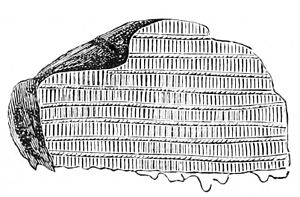Ohio River at Shawneetown to the Mississippi, and at some places attains a height of about 700 feet, being the highest land in Illinois or in either of the adjoining States of Missouri, Kentucky, and Indiana. Immediately south of the salt-springs is a spur of the main hill, its northern terminus being precipitous bluffs of metamorphic sandstone, which Prof. Worthen, the State Geologist of Illinois, who once visited the location with me, classed with the Chester group. Above this bluff, where the spur rises at an angle of about 30°, it has been terraced, and the terraces as well as the crown of the spur have been used as a cemetery: portions of the terraces are still perfect; all the burials appear to have been made in rude stone cists, that vary in size from eighteen inches by three feet, to two feet by four feet, and from eighteen inches to two feet deep. They are made of thin-bedded sandstone slabs, generally roughly shaped, but some of them have been edged and squared with considerable care, particularly the covering-slabs. The slope below the terraces was thickly strewed with these slabs, washed out as the terraces have worn away, and which have since been carried off for door-steps and hearthstones.

Fig. 2.
I have opened many of these cists; they nearly all contain fragments of human bones far gone in decay, but I have never succeeded in securing a perfect skull; even the clay vessels that were interred with the dead have disintegrated, the portions remaining being almost as soft and fragile as the bones.
Some of the cists that I explored were paved with valves of fresh-water shells, but most generally with the fragments of the great salt-pans, which, in every case, are so far gone in decay as to have lost the outside markings. This seems conclusively to couple the tenants of these ancient graves with the makers and the users of the salt-pans.
The great number of graves and the quantity of slabs that have been washed out prove either a dense population or a long occupancy, or both.
On the crown of the main hill above the cemetery are ranges of circular depressions, from one to three feet deep, and from fifteen to twenty-five feet in diameter; they cover a large area, on two sides of which there is evidence of earthworks.
